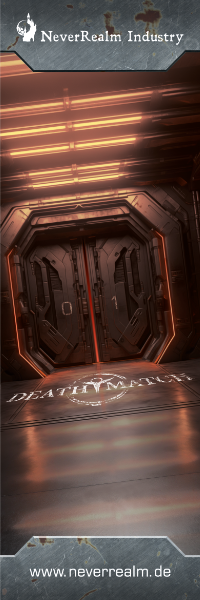Guildball: Die Blacksmiths
Steamforged haben einer weiteren Gilde eine Guildballlizenz ausgestellt.
Today is one of those rare, amazing days in Guild Ball. Today, we get to talk to you about a brand-new Guild entering the fray. Today we can show you the Blacksmiths Guild. This article will give you an introduction to the some of the core concepts that shaped the Blacksmiths Guild during development, and how we chose to represent those concepts on the Pitch.
The Masters of the Blacksmiths Guild are experts at turning raw potential into fearsome destruction. Apprentice Blacksmiths are capable of incredible feats of skill and carnage, but they can only realise their potential under the direction of a Master Blacksmith. To this end, Blacksmith players always work in pairs, a Master and an Apprentice. The Masters are stalwart and aloof, preferring to use their knowledge and experience to disrupt and weaken their opponents so the Apprentices can take advantage.
The first concept that we knew we wanted to include in the Blacksmiths Guild was this idea of the Master and the Apprentice Blacksmith. The working relationship between these two is a core foundation that we built the entire Guild upon, so we wanted to make sure the concept was well represented on the Pitch. All the players in the Blacksmiths Guild are one of two new model types, a [Master] or an [Apprentice].
Another early concept that we developed to demonstrate on the Pitch was the idea that the Blacksmiths Guild are not quite as unified in structure as our more traditional Guilds. In the Empire of the Free Cities Blacksmithing styles, skills, and etiquette differ enormously from city to city. The Masters of the Blacksmith Guild are incredibly proud of the traditions that have been passed down to them through the generations, each of them believing beyond a shadow of a doubt that they are the very best at their craft. As a result, Master and Apprentice Blacksmith pairs can vary quite dramatically from one to the next in how they appear and how they play.
Let’s take a closer look at what the relationship between a Master and an Apprentice means on the Pitch. During the Steamforged Games Ltd Q&A session held at Vengeance 2017, co-founders Mat Hart & Richard Loxam unveiled the first two Blacksmith players, the Master Blacksmith Anvil and his Apprentice Sledge.
There is SO much to talk about even on just these two cards, so let’s start with the basics. The core concept for Anvil & Sledge comes from one of the oldest methods of Blacksmithing, that of the ‘Blacksmith striker’. This method is employed where a piece of metal needs particularly heavy blows in order to shape it properly. A ‘striker’, in Blacksmithing terms, is an Apprentice with a large hammer that takes an enormous amount of focus and energy to wield. So much focus that if a Master were to wield the hammer, the Master may lose track of where they need to ‘strike’ the metal. Having an Apprentice perform this task means that the Master can concentrate on deciding precisely where and how hard the metal needs to be struck. To this end, Sledge is armed with an enormous two-handed hammer, that he can use to smash opponents into paste, and Anvil is armed with a smaller hammer that he can use to ‘mark’ a particularly tough opponent in the exact spot that he wants Sledge to ‘strike’. But how does this translate onto the Pitch?
One of the prominent features of these Blacksmith cards, when compared to each other, is that Anvil and Sledge have VERY different momentous results. Anvil has momentous knock-down, Play Icon, and Push results, whereas Sledge has entirely momentous damage results instead. This is to re-enforce the role that each model type plays on the Pitch. Master Blacksmiths tend to be distant, seeing themselves ‘above’ doing the dirty work a lot of the time. Instead, Master Blacksmiths prefer to use their skills and experience to disrupt and debilitate opponents in preparation for the Apprentices to annihilate in one fell swoop. As a general rule, Master Blacksmiths have a number of ways to increase the capabilities of the Apprentices, whether this is through increasing their TAC, damage, or movement speed. Alternatively, some Master Blacksmiths have several ways to make enemy players vulnerable to attack, such as easy access to knock-down Playbook results, or abilities that lower enemy movement speed, DEF, or ARM.
Perhaps the most prominent aspect of Sledge is his Playbook, and that incredible momentous [7] damage result that it contains. With it, Sledge is clearly capable of singular acts of destruction, but, with a Playbook that is seven columns long Sledge will require the assistance of Anvil to reach it consistently. There are several ways that Anvil can do this. Veterans of Guild Ball will be no stranger to the Singled Out Character Play, which increases the TAC of any player attacking an affected enemy by [+2]. When we create new Guild Ball players we re-use existing abilities where they fit the desired theme. In this way, Singled Out is the perfect example of an existing ability that we used here to show Anvil ‘marking’ an enemy player for Sledge to ‘strike’ with his hammer. In addition to Singled Out, Anvil has incredibly easy access to a momentous knock-down Playbook result, it’s on his first column! A super useful Playbook result for laying a potential target flat out on the Pitch ready for Sledge to flatten further. Lastly, there’s the Tutelage Character Trait on Sledge’s card which allows him to use a Character Play without spending Influence, but only if he activates close to Anvil. That Character Trait is probably very useful with Sledge’s second Character Play… I wonder what it could be…
Where Sledge has the highest Playbook damage result written to date, Anvil is different type of extreme altogether. At [19] HP, with an unprecedented [3] ARM, and the Tough Hide Character Trait. Anvil is certainly up there with the most resilient players in Guild Ball. Just looking at him with his enormous tower shield, attacking Anvil certainly looks like a daunting task. Indeed, in development we made the decision that we wanted the Master Blacksmiths to be more resilient than the average player. To this end, each of the Master Blacksmiths has a particularly defensive speciality. In the case of Anvil, he is designed to be able to take the full force of a charging enemy player and, in most cases, still be on the Pitch once the dust has settled.
A Master Blacksmith’s shield is more than just another piece of armour. A Master Blacksmith’s shield is his or her badge of office, whether it takes the form of a huge tower shield or a forearm mounted buckler. A Master’s shield demonstrates to all who see it their incredible skill in creating near-indestructible defensive equipment. On the Pitch, Master Blacksmiths use their shields to become living defensive positions that the Apprentices can take shelter behind. In the case of Anvil this is represented on the Pitch by the Sentinel Character Trait which increases the ARM of any nearby Apprentices by [1]. A much-needed ARM bonus since the Apprentice Blacksmiths have been designed to be slightly less resilient than the average player. Indeed, Sledge has only [12] HP which is on the low end for a DEF [4+] and ARM [1] player. Blacksmith coaches need to be careful to not get their Apprentices taken-out when trying to get the most out of their supreme offensive potential.
Zusammenfassung:
- Neue Gilde der Schmiede
- Einzigartiges Meister, Azubi Verhältnis bei dem der Meister Spieler den Azubi bufft
Link: Steamforged Games







Und auf Facebook gibt es sogar schon die beiden Minis zu sehen. 😉
Hört sich interessant an,. Hoffe die Minis sind in gewohnter Top-Zinn-Qualität!
… alle neuen Gilden werden nur noch in Plastik erscheinen, soweit mir bekannt :).
Restic, kein Plaste
Woher hast du die Info mit dem Restic? 🙂
Hier sind Bilder von 2 der neuen Blacksmiths:
https://scontent-frt3-1.xx.fbcdn.net/v/t1.0-9/18423693_1325697930858956_5528354774997210093_n.jpg?oh=407ee18a3b556a2e9c429d2f86617402&oe=59B47679
https://scontent-frt3-1.xx.fbcdn.net/v/t1.0-9/18403219_1325697957525620_348991353838295973_n.jpg?oh=3ac82ab22927b84c7df3eeee8adeca8a&oe=59B7D998
Also in minderwertiger Qualität.
Die Info habe ich auch, unter anderem daher, dass ich schon einige Kunststoffmodelle von Guild Ball gesehen habe. 😀
Die Modelle bestehen alle aus PVC (Restic, Brettspielplastik, wie man es am Ende auch immer nennen will), Hartplastik (Gussrahmenplastik) wird es nicht geben.
Spannend ist eben die Frage, ob es auch Zinn geben wird.
Also wenn ich mir die Bilder zu den neuen Farmern anschaue, mache ich mir bei dem neuen Material eigentlich keine Sorgen.
Sfg hatten mal die Ansage gemacht, das sie 2017/18 auf Chinaplastik umstellen werden. Alle neu releasten Gilden beginnend ab Farmer kommen daher direkt in PVC raus
An sich ja schöne Miniaturen aber ich habe den Eindruck dass die Zeit der tollen Posen und filigranen Details Dank dem PVC vorbei ist. Schon die Farmer waren auffällig und hier sieht man es auch. Auch ok, ich spar mir so Geld. Aber laut der ausfrage von SFG legen die Spieler hatten keinen großen Wert auf die Miniaturen, wird dich also für den Hersteller hoffentlich auszahlen…